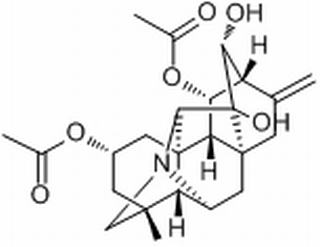Home
Products
Guan-fu base A



| Product Name | Guan-fu base A |
| Price: | Inquiry |
| Catalog No.: | CN00002 |
| CAS No.: | 1394-48-5 |
| Molecular Formula: | C24H31NO6 |
| Molecular Weight: | 429.5 g/mol |
| Purity: | >=98% |
| Type of Compound: | Alkaloids |
| Physical Desc.: | Powder |
| Source: | The herbs of Aconitum coreanum |
| Solvent: | Chloroform, Dichloromethane, Ethyl Acetate, DMSO, Acetone, etc. |
| SMILES: | CC(=O)OC1CC2(CN3C4C2C5(C1)C3C6(C(C7C(C5C6(C4)CC7=C)O)OC(=O)C)O)C |
| Contact us | |
|---|---|
| First Name: | |
| Last Name: | |
| E-mail: | |
| Question: | |
| Description | Guanfu base A is an antiarrhythmic alkaloid isolated from Aconitum coreanum and is a potent noncompetitive CYP2D6 inhibitor, with a Ki of 1.20 μM in human liver microsomes (HLMs) and a Ki of 0.37 μM for the human recombinant form (rCYP2D6). Guanfu base A is also a potent competitive inhibitor of CYP2D in monkey (Ki of 0.38 μM) and dog (Ki of 2.4 μM) microsomes[1]. Guanfu base A also inhibits HERG channel current[2]. |
| Target | CYP2D6[1]; HERG channel[2] |
| In Vitro | Guanfu base A has no inhibitory activity on mouse or rat CYP2Ds. Guanfu base A does not exhibit any inhibition activity on human recombinant CYP1A2, 2A6, 2C8, 2C19, 3A4, or 3A5, but shows slight inhibition of 2B6 and 2E1[1]. Guanfu base A is a potent inhibitor of CYP2D6, with an IC50 recorded at ~0.46 μM in HLM (Dextromethorphan 5 μM) and 0.12 μM in rCYP2D6 (Bufuralol 5 μM)[1]. The effects of Guanfu base A is investigated in human embryonic kidney 293 (HEK293) cells transiently transfected with HERG complementary DNA using a whole-cell patch clamp technique. Guanfu base A inhibits HERG channel current in concentration-, voltage-, and time-dependent manners with an IC50 of 1.64 mM. Guanfu base A shifts the activation curve in a negative direction and accelerated channel inactivation but shows no effect on the inactivation curve[2]. |
| In Vivo | Beagle dogs treated intravenously with Dextromethorphan (2 mg/mL) after pretreatment with Guanfu base A injection shows reduced CYP2D metabolic activity, with the Cmax of dextrorphan being one-third that of the saline-treated group and area under the plasma concentration-time curve half that of the saline-treated group[1]. |
| Density | 1.4±0.1 g/cm3 |
| Boiling Point | 551.4±50.0 °C at 760 mmHg |
| Flash Point | 287.3±30.1 °C |
| Exact Mass | 429.215149 |
| PSA | 96.30000 |
| LogP | 0.93 |
| Vapour Pressure | 0.0±3.4 mmHg at 25°C |